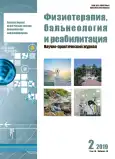Высокочастотный радиоволновый метод в коррекции инволютивных изменений кожи
- Авторы: Юсова Ж.Ю.1, Ахмедбаева И.А.2, Лихтарева А.С.1
-
Учреждения:
- Центральная государственная медицинская академия Управления делами Президента Российской Федерации
- Premium Aesthetics
- Выпуск: Том 18, № 2 (2019)
- Страницы: 92-95
- Раздел: Оригинальные исследования
- URL: https://journals.rcsi.science/1681-3456/article/view/62448
- DOI: https://doi.org/10.17816/1681-3456-2019-18-2-92-95
- ID: 62448
Цитировать
Полный текст
Аннотация
В исследовании представлены данные изучения воздействия монополярного радиочастотного метода на морфофункциональное состояние кожи. Пациенты наблюдались с различными морфотипами инволютивных изменений кожи. По наблюдением находилось 49 пациентов в возрасте от 45 до 55 лет. Все пациенты были разделены на три группы в зависимости от преобладающего морфотипа инволютивных изменений кожи: мелкоморщинистого, деформационного и смешанного. Во всех группах проводилось однократное воздействие с помощью монополярного радиочастотного метода по утвержденному протоколу работы в области лица. Объективные методы исследования включали ультразвуковую сонографию эпидермиса и дермы, адаптированные дерматологические индексы качества жизни (ДИКЖ) и САН (самочувствие, активность, настроение). Оценка результатов проводилась через 3, 6 и 12 мес после проведенного лечения. Полученные данные показали, что высокочастотный радиоволновый метод более эффективен при деформационном и смешанном типах старения по сравнению с мелкоморщинисты.
Полный текст
Открыть статью на сайте журналаОб авторах
Жанна Юсовна Юсова
Центральная государственная медицинская академия Управления делами Президента Российской Федерации
Автор, ответственный за переписку.
Email: zyusova@mail.ru
ORCID iD: 0000-0001-6452-2914
SPIN-код: 7637-1663
д.м.н., проф.
Россия, МоскваИнга Александровна Ахмедбаева
Premium Aesthetics
Email: zyusova@mail.ru
ORCID iD: 0000-0003-0641-8232
Россия, Москва
Анжелика Сергеевна Лихтарева
Центральная государственная медицинская академия Управления делами Президента Российской Федерации
Email: zyusova@mail.ru
Россия, Москва
Список литературы
- Alster T.S., Tanzi E. Improvement of neck and cheek laxity with a nonablative radiofrequency device: a lifting experience // Dermatol. Surg. 2004. Vol. 30. P. 503–7. doi: 10.1111/j.1524-4725.2004.30164.x
- Fitzpatrick R., Geronemus R., Goldberg D., et al. Multicenter study of non-invasive radiofrequency for peri-orbital tissue tightening // Lasers Surg. Med. 2003. Vol. 33. P. 232–42. doi: 10.1002/lsm.10225.
- Bogle M.A., Ubelhoer N., Weiss R.A., et al. Evaluation of the multiple pass, low fluence algorithm for radiofrequency tightening of the lower face // Lasers Surg. Med. 2007. Vol. 39. P. 210–7. doi: 10.1002/lsm.20472.
- Талыбова А.П., Стенько А.Г., Корчажкина Н.Б. Инновационные физиотерапевтические технологии в лечении комбинированных рубцовых изменений кожи // Физиотерапевт. 2017. № 1. С. 47–55.
- Круглова Л.С., Котенко К.В., Корчажкина Н.Б., Турбовская С.Н. Физиотерапия в дерматологии. М.: ГЭОТАР-Медиа, 2016. 303 с.
- Юсова Ж.Ю., Потекаев Н.Н., Логина Н.Ю., Зубахин А.Г. Классификация инволюционных изменений кожи // Экcпериментальная и клиническая дерматокосметология. 2011. № 5. С. 3–6.
- Юсова Ж.Ю., Соловьева Е.В., Иванова М.А. Инволюционные изменения кожи и микроциркуляторного русла // Научные ведомости Белгородского государственного университета. Серия: Медицина. Фармация. 2012. Т. 20. № 22-2. С. 97–100.
- Юсова Ж.Ю. Инволюционные изменения кожи с учетом типа ее старения // Научные ведомости Белгородского государственного университета. Серия: Медицина. Фармация. 2012. Т. 20. № 22-2. С. 83–88.
- Юсова Ж.Ю., Кузнецова А.О., Соколова-Меркурьева А.В., Кливитская Н.А. Реабилитация кожи после агрессивных процедур // Пластическая хирургия и косметология. 2013. № 3. С. 447–453.
- Юсова Ж.Ю., Кузнецова А.О. Комбинированный метод коррекции инволюционных изменений кожи // Экcпериментальная и клиническая дерматокосметология. 2013. № 5. С. 47–53.
- Weiss R.A., Weiss M.A., Munavalli G., et al. Monopolar radiofrequency facial tightening: a retrospective analysis of efficacy and safety in over 600 treatments // J. Drugs Dermatol. 2006. Vol. 5. P. 707–12.
- Fritz M., Counters J.T., Zelickson B.D. Radiofrequency treatment for middle and lower face laxity // Arch Facial Plast Surg. 2004;6:370–3. doi: 10.1001/archfaci.6.6.370.
- De Felipe I., Del Cueto S.R., Perez E., et al. Adverse reactions after non-ablative radiofrequency: follow-up of 290 patients // J. Cosmet. Dermatol. 2007. Vol. 6. P. 163–6. doi: 10.1111/j.1473-2165.2007.00322.x.
- Narins R.S., Tope W.D., Pope K., et al. Overtreatment effects associated with a radiofrequency tissue-tightening device: rare, preventable, and correctable with subcision and autologous fat transfer // Dermatol. Surg. 2006. Vol. 32. P. 115–24. doi: 10.1111/1524-4725.2006.32019.
- De Felipe I., Redondo P. Animal model to explain fat atrophy using nonablative radiofrequency // Dermatol. Surg. 2007. Vol. 33. P. 141–5. doi: 10.1111/j.1524-4725.2006.33031.x.
- Abraham M.T., Ross E.V. Current concepts in nonablative radiofrequency rejuvenation of the lower face and neck. Facial Plast Surg. 2005;21:65–73. doi: 10.1055/s-2005-871765.
- Finzi E., Spangler A. Multipass vector (mpave) technique with nonablative radiofrequency to treat facial and neck laxity. Dermatol Surg. 2005. Vol. 31. P. 916–22. doi: 10.1111/j.1524-4725.2005.31805.
Дополнительные файлы







